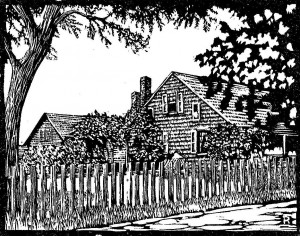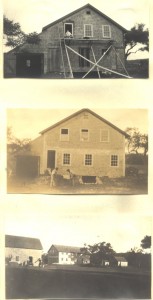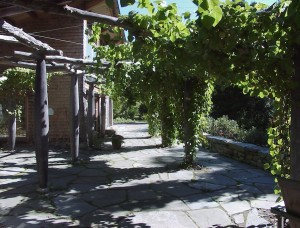History
Early Years 
The farm acquired by Polly’s family in 1926may be traced back in the historical record to 1669. The Arboretum’s offices are housed in the renovated Homestead, a building dating from the 1700s. Other historic structures on the property include the Far Barn, now used for lectures and special events, and the Cowbarn, which houses a horticulutral library and an apartment for visiting professionals.
The Arboretum property was once one of sixteen original “home lots” created in the town. In 1669 four associates, known as the original proprietors, purchased a large parcel of land from Josias, the Indian Sachem of Takemmy. Soon after the initial purchase the parcel was divided into forty acre “home lots”, and sold off. The original settler of this lot was Henry Luce. Early town records indicate that he settled here by 1674.He was chosen as surveyor of highways, 1675; juror, 1677 and 1681, and selectman, 1687. By the time of his death sometime between 1687 and 1689 he and his wife Remember had ten children.
Historian Charles Banks noted in “The History of Martha’s Vineyard” that Henry Luce had a dwelling on his property at the end of the 17th century. It is unknown where this dwelling stood, but may have been closer to the Mill Brook, to the East of where the Barnard Luce homestead lies. It is known that the building called the Homestead was occupied by the Luce family from its construction (mid to late 1700s) until 1860. The last Luce to own the property was Barnard Luce, (1778 – 1856) who operated a tavern here known as Barnard Luce’s Inn.
After his death the property changed hands a few times until Bartlett Smith purchased the farm, and with his partner Albert Littlefield, ran it as a sheep farm. Littlefield later married Smith’s sister, eventually inheriting all of Smith’s land.
Butcher/Hill Years
 In 1926 the Littlefield’s sold 40 acres, including the Homestead and other farm buildings to Polly’s parents, Margaret and Howard Butcher, Jr., for a summer home. Margaret Butcher named the property the Barnard’s Inn Farm to honor Barnard Luce and the inn he once operated from the Homestead. Margaret Butcher was a gifted architect and decorator and for thirty years she repaired and modernized the farm buildings, including renovating the old barn into the family home, known as the Cowbarn.
In 1926 the Littlefield’s sold 40 acres, including the Homestead and other farm buildings to Polly’s parents, Margaret and Howard Butcher, Jr., for a summer home. Margaret Butcher named the property the Barnard’s Inn Farm to honor Barnard Luce and the inn he once operated from the Homestead. Margaret Butcher was a gifted architect and decorator and for thirty years she repaired and modernized the farm buildings, including renovating the old barn into the family home, known as the Cowbarn.
Eventually Polly Hill and her husband Julian inherited the farm. In 1957, at the age of 50, the idea of growing an arboretum first emerged in Polly’s mind. Over the years her hard work, dedication, and enthusiasm resulted in the landscape we maintain today. Polly always wanted her arboretum to be of use to the community but it was beyond her wildest dreams that her land would become a public arboretum. In 2001 reflecting on her good fortune she said, “Who could dream of such an organization? Certainly I never expected any part of it. Lucky? Yes. Unprecedented.”
From Private to Public
This transition was made possible when Dr. David H. Smith met Polly through an introduction by the Vineyard Conservation Society. Dr. Smith, impressed with the scientific nature of the plant collection, approached Polly and her family and arranged for the purchase of the property. The non-profit organization, the Polly Hill Arboretum Inc., was created to preserve Polly’s botanical and horticultural legacy, to maintain the property, and continue Polly’s ideals of plant research, education, and conservation. The purchase was accomplished through donations by David H. Smith, the Hill family, and many of Polly’s horticultural colleagues. The Commonwealth of Massachusetts joined in preserving the Arboretum property by providing funding for a conservation restriction, which will prevent development of the property in perpetuity.
The Visitor Center, constructed in 1998, consists of two post-and-beam buildings designed by the award-winning architectural firm of Maryann Thompson Architects of Cambridge,  Massachusetts. The master plan for the Arboretum, including the design and layout of the parking area, was developed by the well-known, award winning landscape architect and Martha’s Vineyard resident, Michael Van Valkenburgh of Michael Van Valkenburgh Associates, also of Cambridge.
Massachusetts. The master plan for the Arboretum, including the design and layout of the parking area, was developed by the well-known, award winning landscape architect and Martha’s Vineyard resident, Michael Van Valkenburgh of Michael Van Valkenburgh Associates, also of Cambridge.
Stephen Spongberg, a long associate of Polly’s and a horticultural taxonomist with the Arnold Arboretum became PHA’s first Executive Director in 1998. Steve’s clear understanding of Polly’s vision for her property, combined with his experience at the Arnold Arboretum resulted in a smooth transition from a private garden to a public arboretum. After six successful years working to build the Arboretum Steve retired in 2004. He remained involved as a volunteer overseeing our extensive library collection until his passing in 2021.
Tim Boland, who first held position as Curator, became Executive Director in October 2004. Tim is looking forward to many years leading the arboretum in its next stages of development. As Tim say’s, “This is a garden of ideas, a lot of Polly’s ideas and a lot of our ideas…the human element is the focus, connecting plants and people.
In 2002 an additional 10 acres were acquired in cooperation with the MV Museum and the MV Agricultural Society. In 2007 a greenhouse and nursery facility were added. The new Littlefield Maintenance Building, located adjacent to the greenhouse, was opened in 2009. In 2011 an additional 2 acres were added to the southern boundary bringing the total acreage to 72. Construction on a new Education Center & Botany Lab began in the fall of 2015 and was completed in summer 2016.
Learn more about David Smith in the video David Hamilton Smith Story
Historic Recognition
In 2015 we received welcome news: the National Park Service has listed PHA as the Polly Hill Arboretum Historic District in the National Register of Historic Places. This formal recognition of the Arboretum’s significance based on national standards honors the exceptional importance of our historic property as well as our preservation efforts.
The listing is the culmination of years of work undertaken with assistance from the West Tisbury Local Historic Commission (WTLHC). We are particularly proud for it honors Polly Hill’s original vision for her property. “The landscape design of Barnard’s Inn Farm was bequeathed to us by generations of farmer-owners,” noted Polly in a 1998 interview. Her plans included “trying not to spoil the character of the old farm and its inherited landscape.” At PHA we continue to respect the historic buildings, stone walls, and open meadows that provide a template for our work.
While the Arboretum is known for its remarkable collection of woody plants, it is equally significant as a rare surviving agricultural landscape. PHA is one of the only historic farmsteads remaining on the Vineyard that is open to the public. In addition we are part of a larger area of conserved open space in West Tisbury, helping to preserve the town’s rural character. The National Register of Historic Places listing recognizes both the integrity of our landscape and the extraordinary efforts of Polly Hill: “The Polly Hill Arboretum Historic District retains integrity, and its present appearance clearly conveys the property’s evolution across 300 years of island history, from colonial farm to summer retreat to arboretum.”
The complex process of applying for the National Register involved extensive research and collaboration with many people and organizations. Special recognition goes to Education, Membership & Outreach Coordinator Karin Stanley who was instrumental in this effort. We would also like to thank Jill Bouck, Dick Burt, Anne Fisher, Leslie Gray, and Ellen Weiss of the WTLHC, as well as many others too numerous to list here.
For more information on this historic property see our listing in the historic inventory of Massachusetts.
Massachusets Historic Commission Area Form